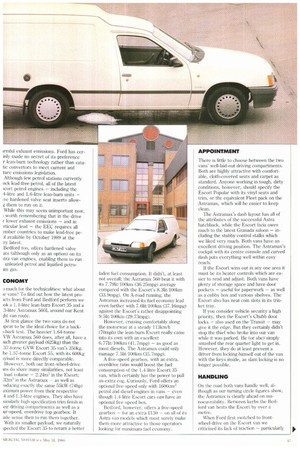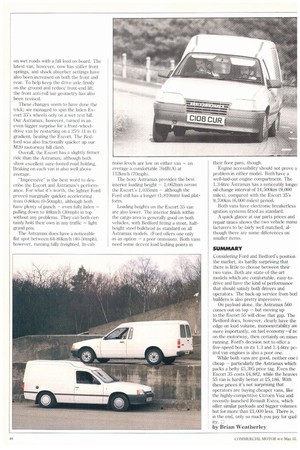DUEL FOR DOMINATION
Page 66

Page 67

Page 68

If you've noticed an error in this article please click here to report it so we can fix it.
Competition is hot at the top of the car-derived van market, now that Ford has launched its "lean-burn" engine. We test the two fiercest contenders back-to-back • "Deadly rivals", is probably the nicest way of describing Ford and Bedford in the UK car-derived van market. Both manufacturers have long since overtaken Austin Rover (still without a diesel engine) and are now slugging it out to be number one in a market that accounts for 30% of all commercial vehicles sold in Britain.
Like the cut-throat car market on which it is based, the CDV sector has a relatively high turnover of new models. Ford and Bedford are no exception to this rule. Both have launched new vans within the past nine months. In August 1985 it was Bedford's turn with the Astramax-produced at the Vauxhall Ellesmere Port plant on Merseyside. Then in February this year, Ford introduced its latest Escort van — built across the river at Halewood.
Both models are a mixture of old and new. Beneath the Astrarnax's new, stylish wind-cheating body — which offers up to 24% more load space than the basic Astra Van, are GM's tried-and-tested, high-revving Series I and II engines and gearboxes. This driveline combination
(reported in previous tests by CM) has already proved itself in the Astra Van w well as in Vauxhall's own hatchback and saloon car models.
By contrast the latest Ford Escort vai has the same basic body shell — albeit with the distinctive "family Ford" frontend and an updated driving compartment but with a new range of petrol engines, including the much-publicised 55kW (74hp), I.4-litre and 66kW (88hp) CV11 "lean-burn" units.
Why lean-burn? The name comes frac the engine's ability to run on an air/fuel ratio of up to 18:1 at light load, compare with similar conventional engines which operate on 14 or 15:1, Ford achieves thi by using a specially-shaped combustion chamber which creates extremely thorough petrol/air mixing. This means the 1.4-litre and 1.6-litre engines can rui smoothly on far weaker — or leaner — fuel mixtures, over a wider range of conditions than ever before.
While there are some benefits in fuel economy, the most important environmental aspect of the lean-burn engine is that it is a lot cleaner, producing far lest innful exhaust emissions. Ford has cerinly made no secret of its preference r lean-burn technology rather than catatic convertors to meet current and ture emissions legislation.
Although few petrol stations currently ock lead-free petrol, all of the latest 5cort petrol engines — including the 4-litre and 1.6-litre lean-burn units — ive hardened valve seat inserts allowthem to run on it.
While this may seem unimportant now, ; worth remembering that in the drive r lower exhaust emissions — and in rticular lead — the EEC requires all ember countries to make lead-free pe)1 available by October 1989 at the ry latest.
Bedford too, offers hardened valve ats (although only as an option) on its Ara van engines, enabling them to run unleaded petrol and liquified petrourn gas.
CONOMY
LI much for the technicalities: what about te vans? To find out how the latest prolets from Ford and Bedford perform we
■ ok a 1.4-litre lean-burn Escort 35 and a 3-litre Astramax 560L around our Kent ;ht van route.
At first glance the two vans do not Tear to be the ideal choice for a back)-back test. The heavier 1.64-tonne VW Astramax 560 does, after all, have a Itch greater payload (625kg) than the 37-tonne GVW Escort 35 van's 350kg. he 1.57-tonne Escort 55, with its 600kg tyload is more directly comparable. However, both our front-wheel-drive ins do share many similarities, not least load volume — 2.24nr3 in the Escort; 32m3 in the Astramax — as well as -oducing exactly the same 55kW (74hp) aximum power from their respective 4 and 1.3-litre engines. They also have similarly high specification trim finish in eir driving compartments as well as a ur-speed, overdrive top gearbox. It ade sense then to run them together. With its smaller payload, we naturally cpected the Escort 35 to return a better
laden fuel consumption. It didn't, at least not overall; the Astramax 560 beat it with its 7.791it/100km (36.25mpg) average compared with the Escort's 8.31it/100km (33.9mpg). On A-road running, the Astramax increased its fuel economy lead even further with 7.61it/100km (37.16mpg) against the Escort's rather disappointing 9.51it/100kni (29.73mpg).
However, cruising comfortably along the motorway at a steady 113km/h (70mph) the lean-burn Escort really came into its own with an excellent 6.771k/100km (41.7mpg) — as good as most diesels. The Astramax could only manage 7.5lit/100krn (35.7mpg).
A five-speed gearbox, with an extra, overdrive ratio would boost the fuel consumption of the 1.4-litre Escort 35 van, which certainly has the power to pull an extra cog. Curiously, Ford offers an optional five-speed only with 1600cm' petrol and diesel engines in vans — even though 1.4-litre Escort cars can have an optional five-speed box.
Bedford, however, offers a five-speed gearbox — for an extra V130 — on all of its Astra van models which must surely make them more attractive to those operators looking for maximum fuel economy. APPOINTMENT There is little to choose between the two vans' well-laid-out driving compartments. Both are highly attractive with comfortable, cloth-covered seats and carpet as standard. Anyone working in tough, dirty conditions, however, should specify the Escort Popular with its vinyl seats and trim, or the equivalent Fleet pack on the Astramax, which will be easier to keep clean.
The Astramax's dash layout has all of the attributes of the successful Astra hatchback, while the Escort facia owes much to the latest Granada saloon — including the stubby control stalks which we liked very much. Both vans have an excellent driving position. The Astramax's cockpit with its centre console and curved dash puts everything well within easy reach.
If the Escort wins out in any one area it must be its heater controls which are easier to read and adjust. Both vans have plenty of storage space and have door pockets — useful for paperwork — as well as a cubby box and various shelves. The Escort also has neat coin slots in its trinket tray.
If you consider vehicle security a high priority, then the Escort's Chubb door locks — also used on the Transit — may give it the edge. But they certainly didn't stop the thief who broke into our van while it was parked. He (or she) simply smashed the rear quarter light to get in. However, they do at least prevent a driver from locking himself out of the van with the keys inside, as slam locking is no longer possible.
HANDLING On the road both vans handle well, although as our turning circle figures show, the Astramax is clearly ahead on manoeuvrability. Between kerbs the Bedford van beats the Escort by over a metre.
When Ford first switched to frontwheel-drive on the Escort van we criticised its lack of traction — particularly on wet roads with a full load on board. The latest van, however, now has stiffer front springs, and shock absorber settings have also been increased on both the front and rear. To help keep the drive axle firmly on the ground and reduce front-end lift. the front anti-roll bar geometry has also been revised.
These changes seem to have done the trick; we managed to spin the laden Escort 35's wheels only on a wet test hill. Our Astramax, however, turned in an even bigger surprise for a front-wheeldrive van by restarting on a 25% (1 in 4) gradient, beating the Escort. The Bedford was also fractionally quicker up our M20 motorway hill climb.
Overall, the Escort has a slightly firmer ride than the Astramax, although both show excellent sure-footed road holding. Braking on each van is also well above average.
"Impressive" is the best word to describe the Escort and Astrarnax's performance. For what it's worth, the lighter Ford proved marginally quicker accelerating from 0-80km (0-50mph), although both have plenty of punch — even fully laden — pulling down to 48kmih (30mph) in top without any problems. They can both certainly hold their own in any traffic — light grand prix.
The Astramax does have a noticeable flat spot between 64-80kmih (40-50mph). however, running fully freighted. In-cab noise levels are low on either van — on average a comfortable 76dB(A) at 112kria (70mph).
The boxy Astramax provides the best interior loading height — 1,062mm versus the Escort's 1,035mm — although the Ford still has a longer (1,810mm) load platform.
Loading heights on the Escort 35 van are also lower. The interior finish within the cargo area is generally good on both vehicles, with Bedford fitting a stout, halfheight steel bulkhead as standard on all Astramax models. (Ford offers one only as an option — a poor omission). Both vans need some decent load lashing points in their floor pans, though.
Engine accessibility should not prove a problem in either model. Both have a well-laid-out engine compartment. The 1.3-litre Astramax has a noticeably longei oil-change interval of 14,500km (9,000 miles), compared with the Escort 35's 9,700km (6,000 miles) period.
Both vans have electronic breakerless ignition systems fitted as standard.
A quick glance at our parts prices and repair times shows the two vehicle manu facturers to be fairly well matched, although there are some differences on smaller items.
SUMMARY
Considering Ford and Bedford's position the market, its hardly surprising that there is little to choose between their two vans. Both are state-of-the-art models which are comfortable, easy-todrive and have the kind of performance that should satisfy both drivers and operators. The back-up service from both builders is also pretty impressive.
On payload alone, the Astramax 560 comes out on top — but moving up to the Escort 55 will close that gap. The Bedford does, however, clearly have the edge on load volume, manoeuvrability an more importantly, on fuel economy—if nc on the motorway, then certainly on mixet running. Ford's decision not to offer a five-speed box on its 1.3 and 1.4-1itre petrol van engines is also a poor one.
While both vans are good, neither one i cheap — particularly the Astramax which packs a hefty ,E5, 395 price tag. Even the Escort 35 costs £4,882, while the heavier 55 van is hardly better at £5,186. With these prices it's not surprising that operators are buying cheaper vans, like the highly-competitive Citroen Visa and recently-launched Renault Extra, which offer similar payloads and bigger volumes but for more than £1,000 less. There is, in the end, only so much you pay for qual. ity.
by Brian Weatherley




















































































